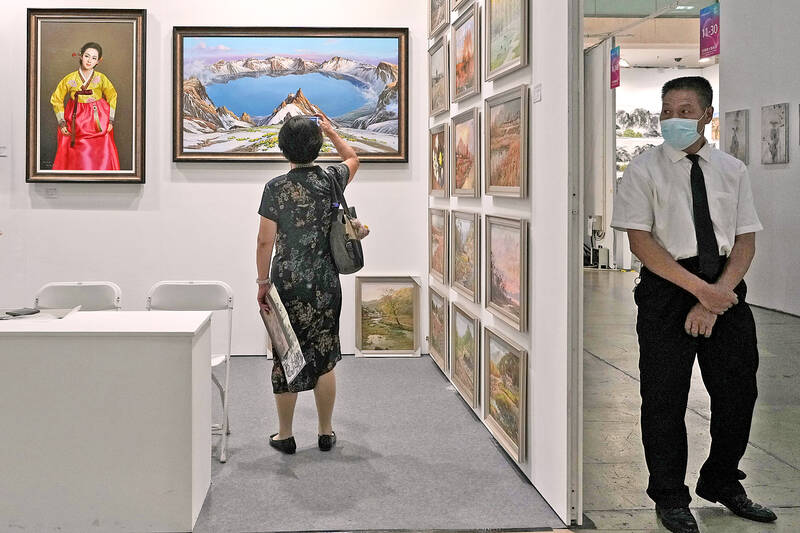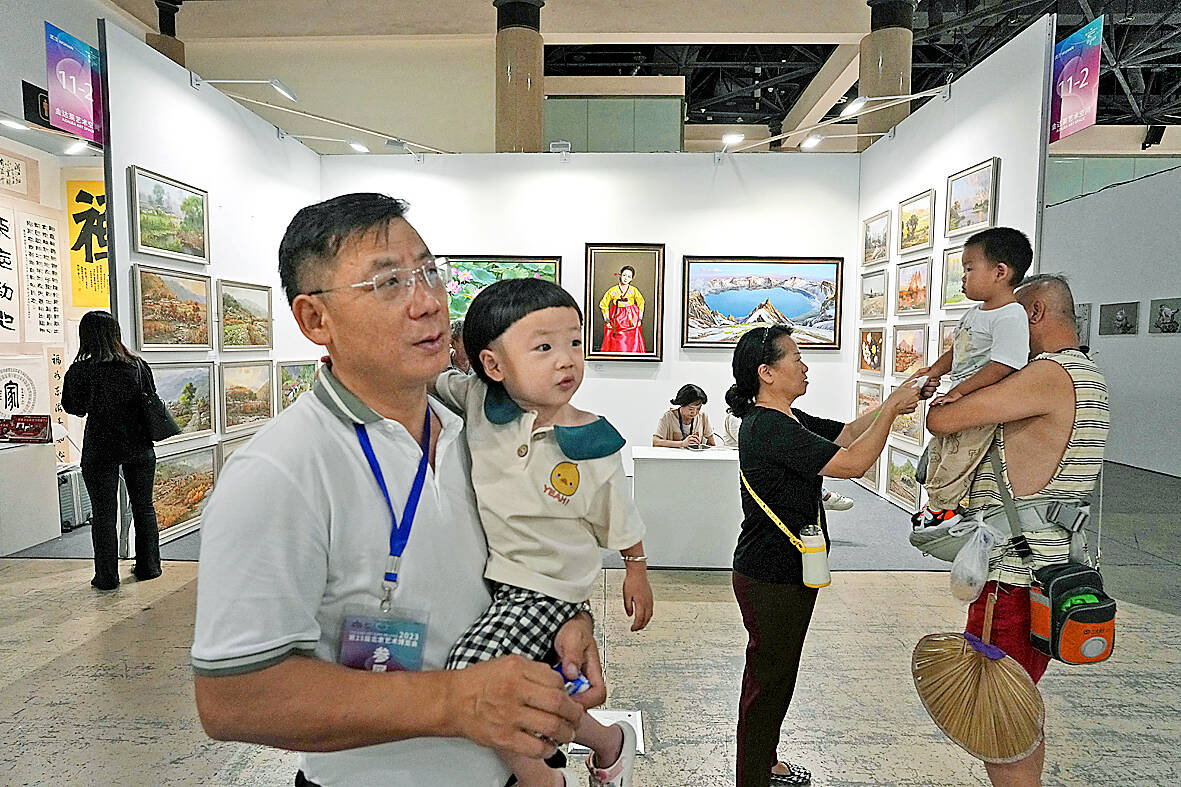For sale at a recent Beijing art exposition was a painting with an asking price of US$2,460 that depicted the snow-capped Mount Baekdu, the mythical birthplace of the Korean people.
A portrait of a prim young lady in bright brushstrokes was being sold for US$5,190. For buyers on a budget, there were colorful landscapes being offered for a few hundred dollars.
The dealer hawking the art made no effort to disguise who produced the pieces, despite stiff UN sanctions prohibiting the sale of such goods.

Photo: AP
“They were painted over there,” the dealer said, “in North Korea.”
The dealer, who had salt-and-pepper hair and refused to divulge his name, was a representative of an art gallery that trumpets itself as China’s premier seller of North Korean art. The gallery, The Paintings Say Arirang, also operates a studio for North Korean artists in the outskirts of Beijing.
Housed in a fenced and heavily surveilled compound, the North Koreans paint glorified, idyllic visions of life back home. For the right price, the Arirang studio says, the artists will render “exquisite” portraits at “unimaginable prices.”

Photo: AP
SANCTIONS
The gallery’s existence and conspicuous sales tactics, experts say, highlight China’s lax enforcement of UN sanctions targeting North Korea to stymie Pyongyang’s nuclear program. The UN has sanctioned a long list of North Korean goods, including arms, coal, oil and art. The UN has also sought to block North Koreans from working overseas in the hopes of preventing North Korea from garnishing the wages of such laborers. A UN report in March singled out Arirang for selling North Korean art and hosting North Korean artists in apparent violation of sanctions.
China has a long history of rebuffing efforts by the UN to rein in such suspected sanctions violators, and last year vetoed a UN resolution that would have toughened such restrictions. The UN reported that Arirang did not respond to requests for information.
Arirang was not hard for the UN to find. That’s because the gallery is actively seeking to tap a niche audience drawn to the unique, socialist realist style of North Korean artists.
Arirang was founded by Jin Zhe, an ethnic Korean and art lover born in China near the North Korean border, according to posts written by Jin on Arirang’s Web site. The son of a prominent painter, Jin spent years at a Chinese state-run radio station before a trip to Pyongyang instilled a taste for North Korean art. Jin, Arirang’s director, couldn’t be reached for comment.
An Arirang employee said by phone that the studio was in operation and offered a tour of the complex. She also said the studio was selling customized portraits by its North Korean artists. The employee, a woman identifying herself as surnamed Shen, changed her story a few days later, saying the base wasn’t in operation because “business is bad.”
When journalists visited the “painting base,” guards turned them away.
‘PURE AESTHETICS’
In lengthy posts on Chinese chat application WeChat, the art gallery expounds at length on the beauty rendered by North Korean artists because they are free from the fetters of the “market economy.”
“They do not compare who is richer than the other, but simply focus on pure aesthetics,” Arirang wrote on WeChat. “They regard the pursuit of art as a mission of spiritual civilization,” not vulgar commodification.
Such art is exceptionally valuable, Arirang said, “because of its superb realistic skills, high-cost performance, high collection value and other advantages.”
In most countries, art is seen as a form of self-expression. But in North Korea it is strictly regulated. Artists work directly for North Korea’s propaganda authorities, and their mission is to create art glorifying the state and its socialist, nationalist ideology.
Their work also provides income for the North Korean state.
“All artists in North Korea are slaves to the Party,” said Song Byeok, a dissident artist who painted propaganda posters in North Korea until he fled to the South two decades ago. “North Korean art is a tool of the Kim family, with no identity of its own.”
Posts on Arirang provide glimpses of the artists’ lives in China. In one photo, they raise glasses of beer around sizzling barbecue. Others show them playing ping pong or visiting historic monuments and bustling market streets.
Nearly a thousand paintings had been rendered in Arirang’s “painting base,” Jin wrote on WeChat. The artists work hard, often refusing breaks, the gallery’s director added.
“It’s very relaxing, no worries,” Jin recounted one artist saying.
Another told Jin that they can’t sleep until they were done, Jin said.
BG Muhn, an expert in North Korean art at Georgetown University, said artists enjoy special care and respect in North Korean society.
“The interesting thing is they don’t consider themselves doing propaganda art,” said Muhn, who met artists on nine trips to North Korea. “They feel they are doing art for the country, to serve the country and the people.”
CASH NEEDED
For decades, North Korean art was created largely for North Korean audiences. That changed in the 1990s when Pyongyang’s biggest benefactor, the Soviet Union, collapsed. North Korea desperately needed cash, so it turned to its artists.
The government organized teams of artists to go to friendly countries in Africa and the Middle East, where they erected sculptures and painted murals eulogizing local leaders. Those efforts were financially lucrative. At the same time, the private art market took an interest, especially after South Korea began encouraging trade with its northern neighbor. Tens of thousands of paintings began flowing into South Korea, often through Chinese dealers.
After Kim Jong-un took power in 2011, Pyongyang began loosening its grip on the artists’ creativity. They were told they no longer had to make portraits glorifying state leaders. Business boomed: Pyongyang’s state-run Mansudae studio outfitted a museum in Cambodia and was paid to erect statutes of soldiers and dictators in Senegal, the Congo, Angola, and over a dozen other sites across Africa. North Korea reaped tens of millions of dollars in art sales.
That success evaporated when the UN slapped sanctions on Pyongyang in 2016 and 2017 after a series of nuclear tests. Detectives questioned an art dealer in Italy and seized paintings in South Korea. Pyongyang’s art exports slowed, then ground to a halt when North Korea sealed its borders during the pandemic.
But there are signs that North Korea’s isolation is thawing. China’s relations with North Korea have warmed as ties with the West have soured. Moscow is courting Pyongyang, with Kim visiting Russia last month to discuss arms sales amid the war with Ukraine.
Art and cultural exchanges are now resuming, Jin wrote recently.
“Art is becoming an important way for the outside world to understand North Korea,” Jin wrote on WeChat. “Through unremitting effort and by expanding their horizons, North Korean artists will definitely go abroad and out into the world.”

On April 26, The Lancet published a letter from two doctors at Taichung-based China Medical University Hospital (CMUH) warning that “Taiwan’s Health Care System is on the Brink of Collapse.” The authors said that “Years of policy inaction and mismanagement of resources have led to the National Health Insurance system operating under unsustainable conditions.” The pushback was immediate. Errors in the paper were quickly identified and publicized, to discredit the authors (the hospital apologized). CNA reported that CMUH said the letter described Taiwan in 2021 as having 62 nurses per 10,000 people, when the correct number was 78 nurses per 10,000

May 5 to May 11 What started out as friction between Taiwanese students at Taichung First High School and a Japanese head cook escalated dramatically over the first two weeks of May 1927. It began on April 30 when the cook’s wife knew that lotus starch used in that night’s dinner had rat feces in it, but failed to inform staff until the meal was already prepared. The students believed that her silence was intentional, and filed a complaint. The school’s Japanese administrators sided with the cook’s family, dismissing the students as troublemakers and clamping down on their freedoms — with

As Donald Trump’s executive order in March led to the shuttering of Voice of America (VOA) — the global broadcaster whose roots date back to the fight against Nazi propaganda — he quickly attracted support from figures not used to aligning themselves with any US administration. Trump had ordered the US Agency for Global Media, the federal agency that funds VOA and other groups promoting independent journalism overseas, to be “eliminated to the maximum extent consistent with applicable law.” The decision suddenly halted programming in 49 languages to more than 425 million people. In Moscow, Margarita Simonyan, the hardline editor-in-chief of the

Six weeks before I embarked on a research mission in Kyoto, I was sitting alone at a bar counter in Melbourne. Next to me, a woman was bragging loudly to a friend: She, too, was heading to Kyoto, I quickly discerned. Except her trip was in four months. And she’d just pulled an all-nighter booking restaurant reservations. As I snooped on the conversation, I broke out in a sweat, panicking because I’d yet to secure a single table. Then I remembered: Eating well in Japan is absolutely not something to lose sleep over. It’s true that the best-known institutions book up faster